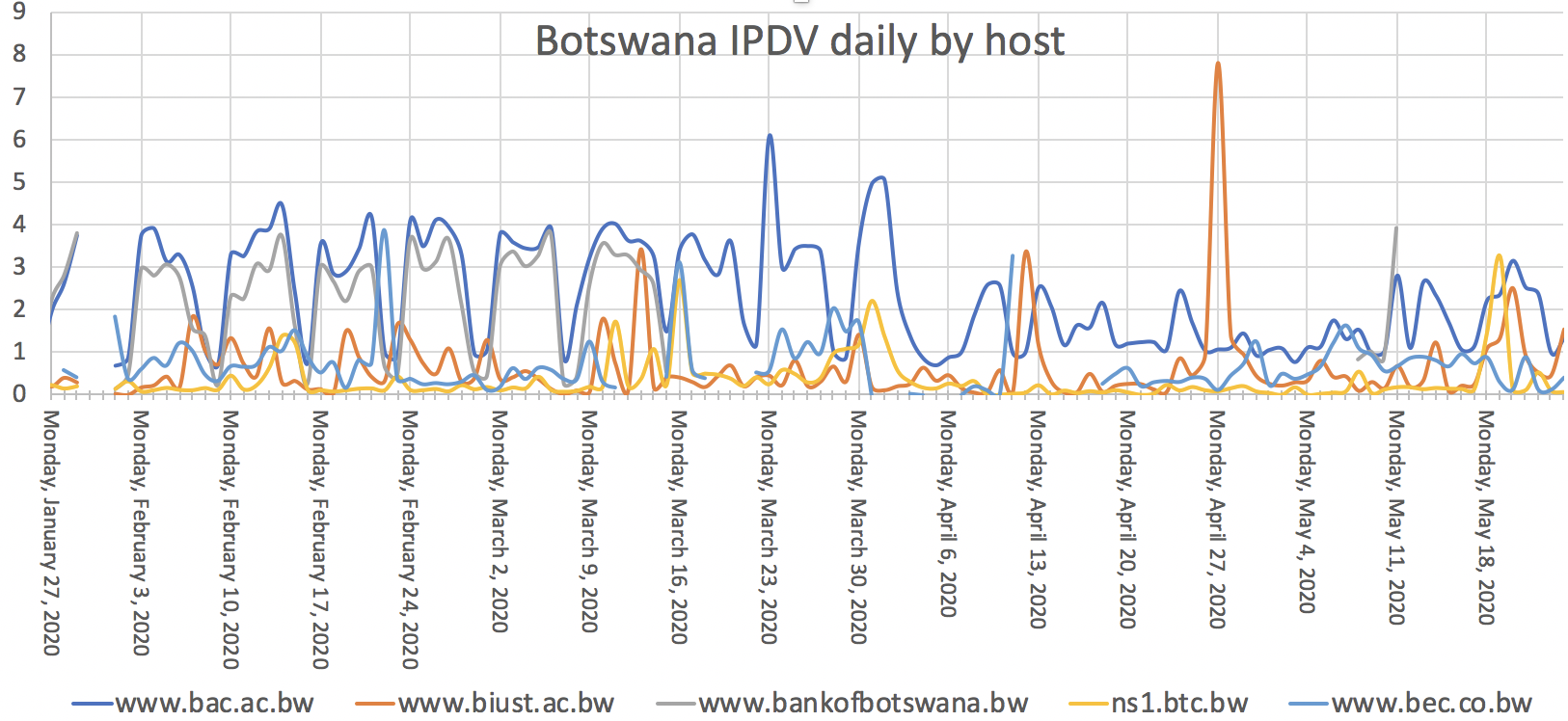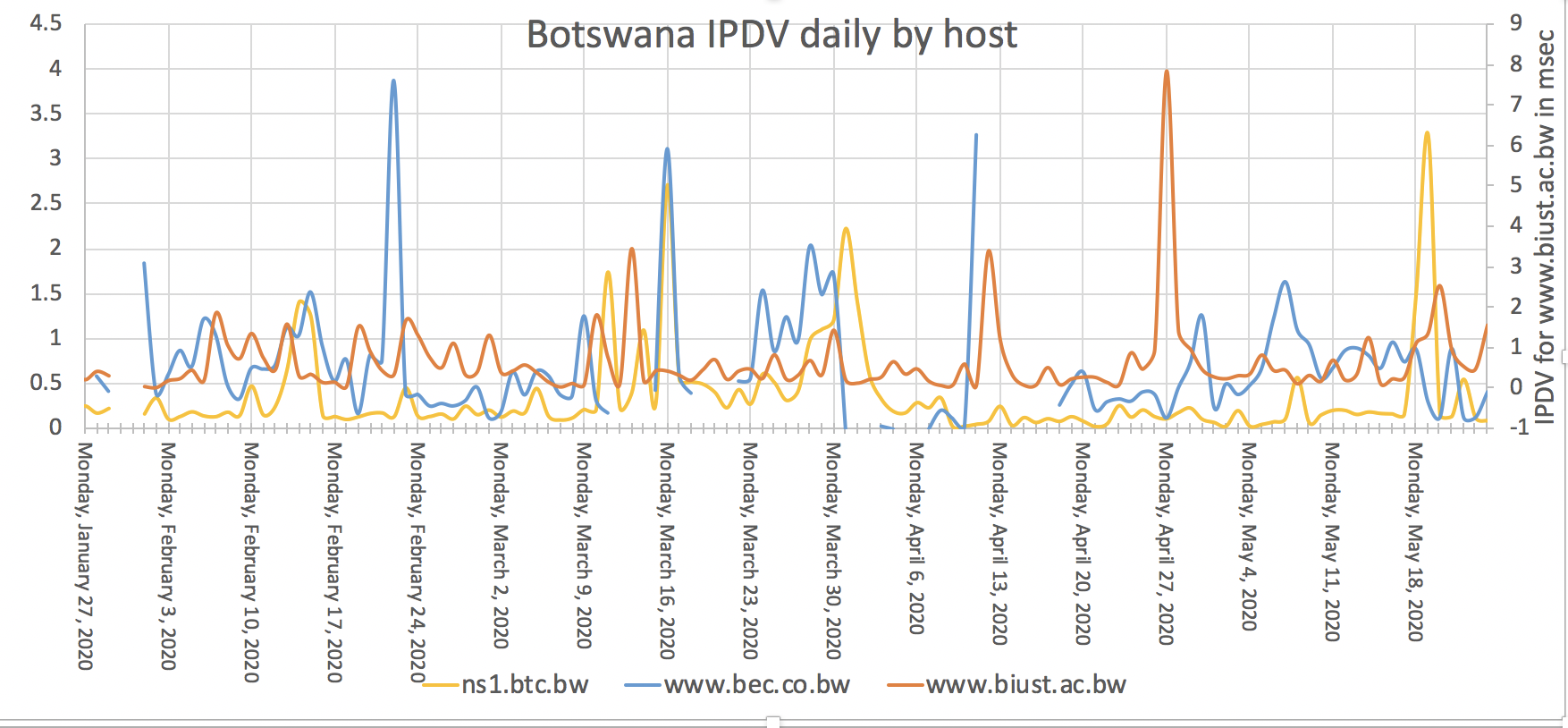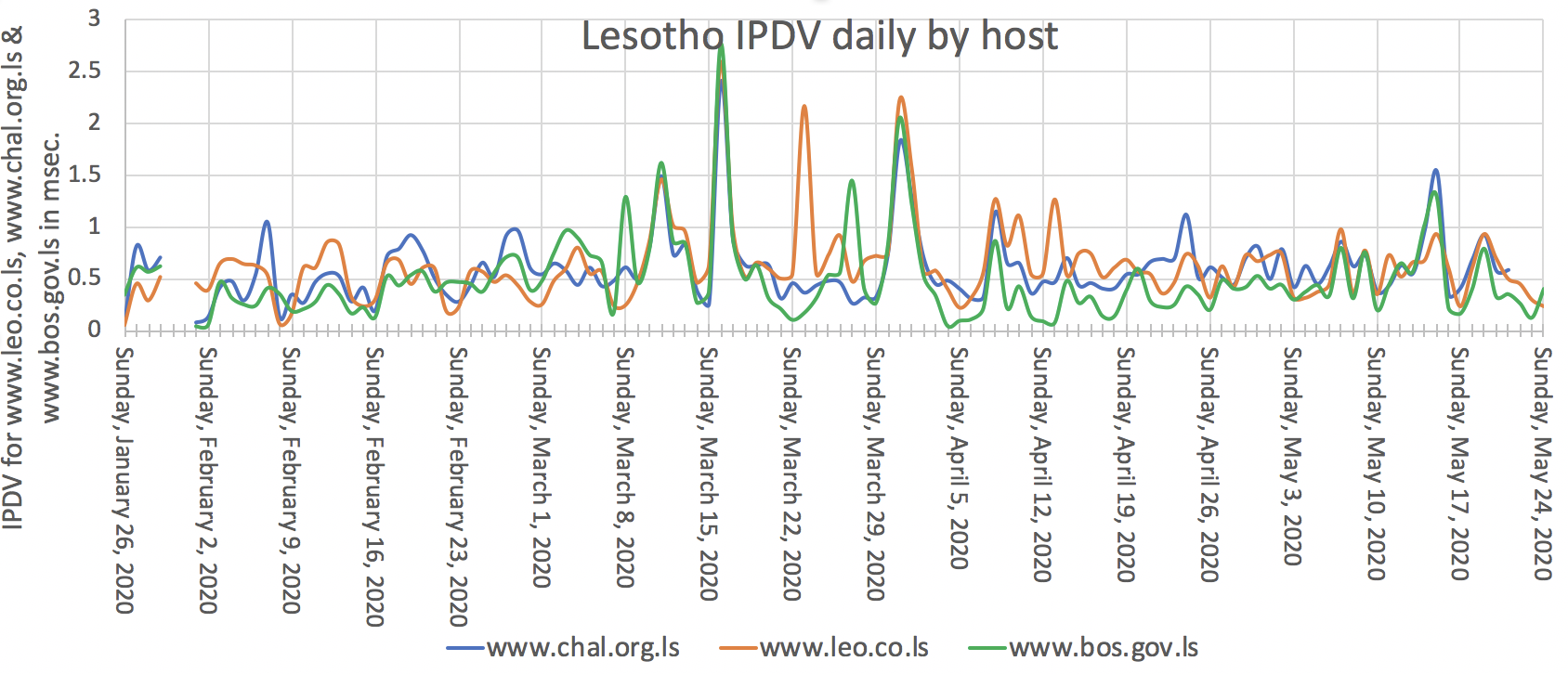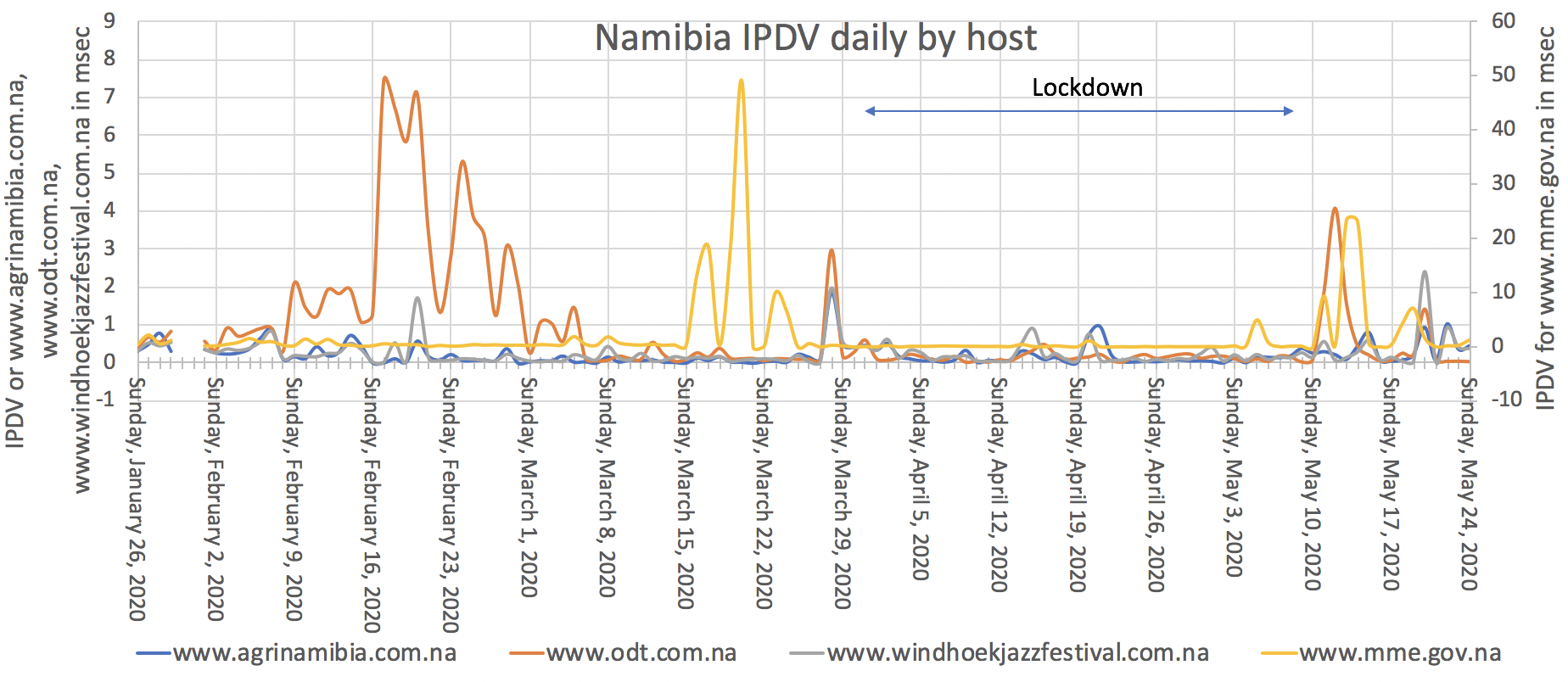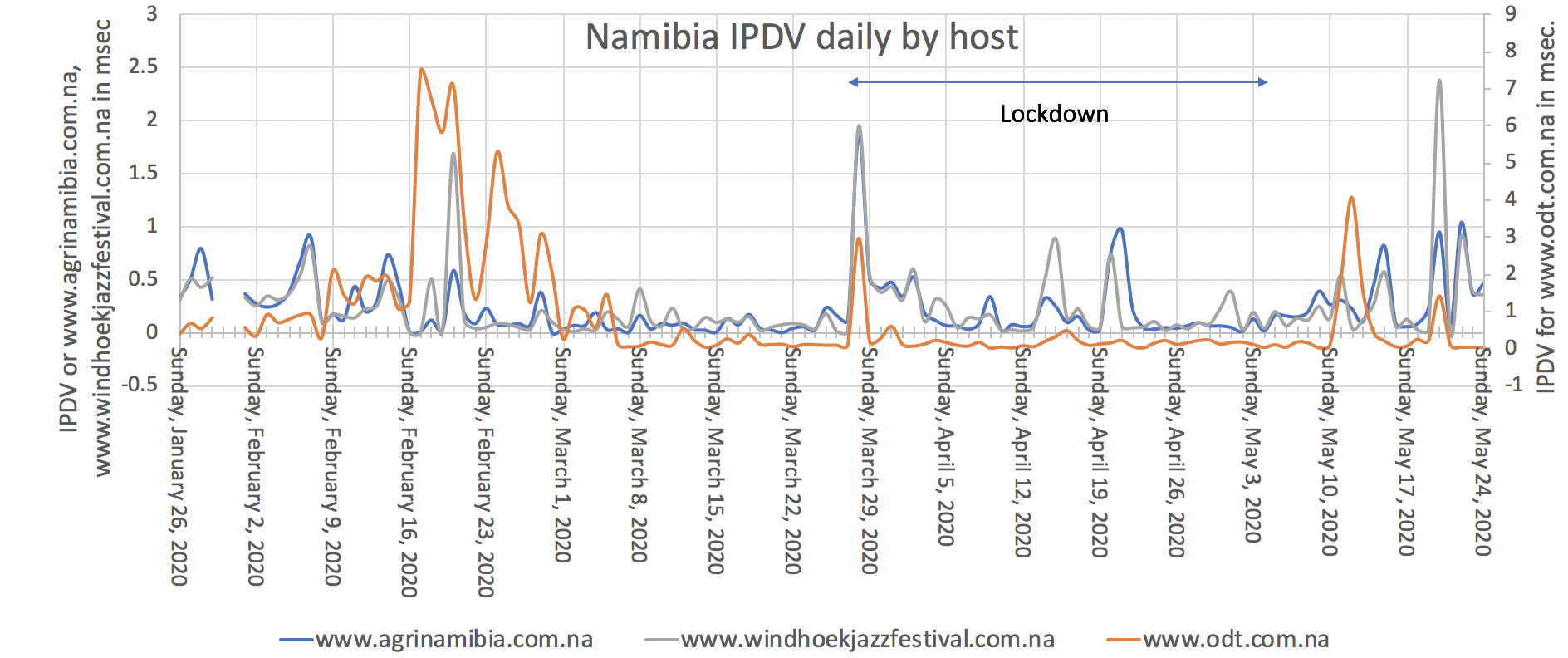Countries bordering the Republic of South Africa
A possibility explored was just selecting hosts in the 6 countries bordering and including South Africa (TLDs BW, LS, SZ, we cover ZA, ZW under E Africa) and then just using hosts with TLDs .co, .com, .go, .gov or including banc or bank in the name. The ideas was that such hosts are probably on commodity networks. However as of May 5th, 2020 these countries have few Covid-19 cases (BW:23, LS: 0, NA 101, SZ (Eswatine): 145, ZA: 218,329, ZW:34). As expected we could not identify a significant impact of Covid-19 on IPDV just by looking at the countries as a whole.
Botswana
PingER monitors five hosts in Botswana. They are: www.bac.ac.bw the Botswana Accountancy College in the capital Gaborone which contains about 10% of Botswana's 2.3 million population, www.biust.ac.bw the Botswana University of Science and Technology in Gaborone, www.bankofbotswana.bw the Bank of Botswana in Gaborone, ns1.btc.bw the Botswana Telecommunications Corporation in Gaborone, and www.bec.co.bw the Botswana Examinations Council in Gaborone. www.bankofbotswana.bw stopped responding on Mar 16.
According to https://en.wikipedia.org/wiki/COVID-19_pandemic_in_Botswana Botswana declared a state of emergency on Mar 31 and on or about Apr 2 went into a lockdown that included extreme social distancing and ended on May 8th.
Looking at the Botswana IPDV daily host chart:
- The IPDV for ns1.btc.bw on around Apr 3 appears to drop by a factor of 5 to 10 compared to the previous 2 weeks. Around May 8 it starts to recover. This matches the lockdown mentioned above.
- www.bac.ac.bw has quite a change in the IPDV curve. Up until the end of March there are big differences in weekday and weekend IPDV measurements. Following Apr 3
the peaks and valleys are much less pronounced, also the average IPDV is lower. - There is no apparent impact of the lockdown on the IPD for www.biust.ac.bw.
- The Bank of Botswana (www.bankofbotswana.bw) stopped responding starting Mar 16 and thus provides no input to the interventions starting in April.
- www.bec.co.bw responses between the second week of March and Apr 18 are intermittent and thus do not enable any clear correlation with the interventions.
If we make a running average of the IPDV over 14 days then the effect of the intervention on Mar 31 on www is clearer (note the reductions in the 14-day average and the standard deviation, see below. For ns1.btc.bw there is again a big dip in both the 14-day average and standard deviation around Apr 2. It should be noted that there was a similar riase around Mar 10.
Lesotho
PingER monitors four hosts in Lesotho. They are: www.bos.gov.ls the Bureau of Statistics in the capital Maseru, www.lce.ac.ls the Lesotho College of Education in Maseru, www.leo.co.ls the Leo Internet Service Provider in Maseru, and www.chal.org.ls the Christian Health Association in Maseru.
According to https://en.wikipedia.org/wiki/COVID-19_pandemic_in_Lesotho: on Mar 18 before the first case Lesotho declared a national emergency and closed schools, on Mar 29 a 3 week lockdown was imposed that was lifted May 5. The first case was May 5.
Looking at a chart of the IPDV for hosts in Lesotho seen from SLAC, it is seen that:
- The week after Mar 18 the IPDV for www.lce.ac.ls starts to drop and by the end of March through the first week in May has dropped by a factor of 2 and no longer exhibits the weekday vs weekend differences
- For the other three hosts there does appear to be increase peaks in IPDV for most of March followed by a factor of 2 reduction for April onwards. Whether this related to Covid-19 we cannot tell.
Namibia
PingER monitors four hosts in Namibia. They are: www.agrinamibia.com.na the Namibia Agricultural Union in the capital Windhoek, www.odt.com.na the Omuramba Medical Centre in Windhoek, www.windhoekjazzfestival.com.na the Windhoek Jazz Festival in Windhoek, and www.mme.gov.na the Ministry of Mines and Energy in Windhoek.
From https://en.wikipedia.org/wiki/COVID-19_pandemic_in_Namibia:
- On 14 March, Namibia reported its first cases of COVID-19,
- By 25 March 2020 the total number of cases reached seven, of which one is thought to be a local transmission.
- On 17 March President Hage Geingob declared a state of emergency as a legal basis to restrict fundamental rights, e.g. to freely move and assemble, guaranteed by the Constitution. The prohibition of large gatherings was clarified to apply to 50 or more people.
- Beginning 27 March, a 21-day lockdown of the regions of Erongo and Khomas Windhoek is in the Khomas region was announced. Inter-regional travel was forbidden, excluding the commuter towns of Okahandja and Rehoboth. Parliament sessions were suspended for the same period, and bars and markets were closed. "Large gatherings" were redefined to 10 people. It was later clarified that the closure of bars applies to all of Namibia, not just the regions under lockdown.The sale of alcohol was forbidden.
- On 14 April the lockdown was extended to 4 May.
- Namibia moved into stage 2 on 5 May 2020. In stage 2 most businesses are allowed to operate again, and people are allowed to move around. Employees over 60 and those chronically sick are to work from home. In public a face mask is to be worn, and social distancing is still to be implemented. Gatherings of more than 10 people, contact sports, bars and gyms are not allowed, alcohol may not be sold, and international borders remain closed.
Looking at the charts below there does appear to be a correlation in the reduction of IPDV during the lockdown. This does not appear to be evident for the other hosts. If there is anything there appears to be an increase compared to the previous 4 weeks
Useful other documents
Coronavirus-free Lesotho relaxes lockdown restrictions, 5/6/2020
Covid-19 9n Africa, from The Center For Disease Dynamics, Economics & Policy

